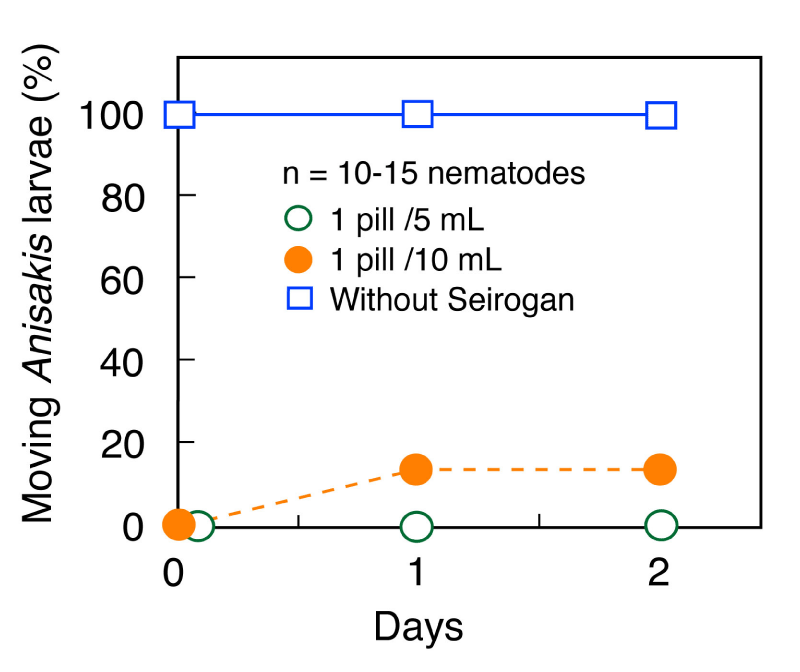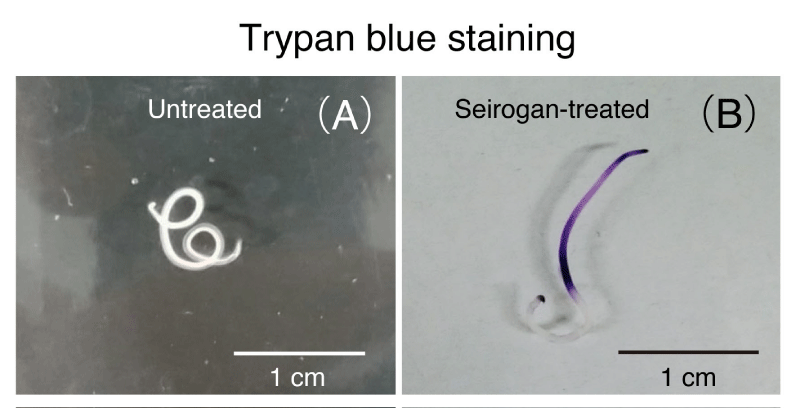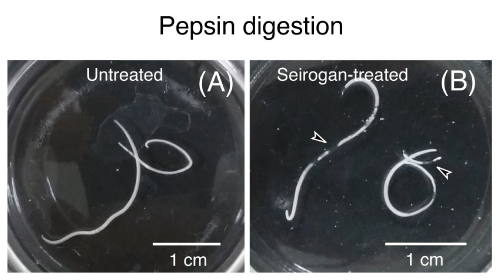Open Journal of Pharmacology and Pharmacotherapeutics
Over-the-counter medicine (Seirogan) containing wood creosote kills Anisakis larvae
Kou Matsuoka1 and Tatsuomi Matsuoka2*
2Department of Biological Science, Faculty of Science and Technology, Kochi University, Kochi 780-8520, Japan
Cite this as
Matsuoka K, Matsuoka T (2021) Over-the-counter medicine (Seirogan) containing wood creosote kills Anisakis larvae. Open J Pharmacol Pharmacother 6(1): 009-012. DOI: 10.17352/ojpp.000017Background: Anisakis food poisoning is characterized by the onset of severe intestinal and stomach pain caused by eating raw or undercooked seafood that harbors the larvae of an anisakid nematode such as Anisakis simplex. Although there is currently no effective drug to kill anisakid nematodes, it has been reported that acetylcholinesterase inhibitors such as the over-the-counter medicine ‘Seirogan’ strongly suppress the nematode’s motility.
Methods: One pill of Seirogan was dissolved in 0.01 M HCl (5 mL or 10 mL), and nematodes were exposed to these test solutions for 30 min. To determine whether the nematodes treated with the Seirogan solutions remained alive or not, the nematodes were exposed to trypan blue solution (widely used for the selective staining of dead tissues).
Results: Most (91.7%) of nematodes whose motility had been prevented by Seirogan treatment (1 pill/10 mL) were stained by trypan blue at 24 h after a 30-min treatment with Seirogan. The majority (83.3%) of Seirogan (1 pill/10 mL)-treated nematodes began to be digested by pepsin treatment within 24 h, whereas all living nematodes not treated with Seirogan remained actively moving despite pepsin treatment. When the posterior 4/5 of a nematode was dipped in Seirogan test solution (1 pill/10 mL), only the dipped portion stopped moving.
Conclusion: A widely available OTC intestinal medicine ‘Seirogan’ kills Anisakis larvae at its normal dose, and the killed nematodes are probably degested in the gastric juice. Seirogan components that are effective for killing nematodes may be absorbed from the nematodes’ body surface.
Introduction
Anisakis food posoning (anisakiasis) is characterized by the onset of severe abdominal pain. It is a parasitic disease caused by eating raw or undercooked seafoods that harbor larvae of the anisakid nematodes such as Anisakis simplex, A. pegreffii and Pseudoterranova decipiens [1,2]. There has been a recent increase in the reported prevalence of anisakiasis worldwide [3,4]. In Japan, anisakiasis accounted for 35% of all cases of food poisoning in 2018 [5]. Once consumed, Anisakis larvae attempt to penetrate into the gastrointestinal wall, inducing severe gastrointestinal pain and serious allergic reactions such as anaphylactic shock against allergens (many proteins of unknown function) sereted from the nematodes or substances on the surface of nematodes [2,6-10]. Anisakis larvae are most frequently detected in the stomach (gastric anisakiasis), whereas bowel anisakiasis is not very frequent [1,11]. In gastric anisakiasis, symptoms occur 2-3 h after the consumption of raw fish or other seafoods [12,13]. Anisakis larvae are tolerant to gastric acid containing pepsin [14] and apparently many tested compounds including anti-nematodal agents such as ivermectin and albendazole [15]. In cases of gastric anisakiasis, the main effective treatment is an endoscopic removal of nematodes [16], while the effective treatment for intestinal anisakiasis has not yet been established.
An acetylcholinesterase inhibitor was reported to suppress the motility of Anisakis larvae (which were considered to be killed) [17]. The major component of the over-the-counter (OTC) medicine ‘Seirogan’ (Taiko Pharmaceutical Co., Osaka, Japan) is wood creosote, which is an acetylcholinesterase inhibitor [18]. Seirogan has been used for >100 years in Asia as a treatment for stomachache or diarrhea due to digestive disorders. Ten years ago, it was reported that the administration of Seirogan alleviates gastric anisakiasis symptoms (a report of two cases) [19]. In addition, in vitro experiment showed that Seirogan quickly suppressed the motility of Anisakis larvae, and resulted in the deformation of the nematodal head and disruption of sheath striation [19]. Based on these results, Seirogan was suggested to suppress the viability of nematodes [19]. However, it is still unclear whether the Seirogan-treated immobile nematodes are killed or temporarily paralysed. The allergens secreted by living nematodes may be responsible for an abrupt hypersensitivity reaction leading to the severe stomach pain or other allergic symptoms [2,9]. If the nematodes are killed by Seirogan administration, the production and secretion of allergens by living nematodes may be stopped, thereby resulting in alleviation of allergic symptom. The nematodes rarely penetrate through the gastrointestinal wall to reach the peritoneal cavity [20]. Such a high-risk case may be avoided if the nematodes are killed by Seirogan administration before they deeply penetrate into the gastrointestinal wall. Therefore, we conducted the present study to determine whether or not Seirogan kills Anisakis larvae.
Materials and methods
Samples
Anisakis simplex L3 larvae (15-30mm) were isolated from internal organs of mackerel and pacific cod, and then maintained in 0.9% NaCl at room temperature (~25oC). A. simplex larva was identified by the shape of stomach and protrusion of posterior end.
Treatment with seirogan
One pill (containing 44 mg of wood creosote) of Seirogan (Taiko Pharmaceutical Co.) was dissolved in 5 mL or 10 mL of 0.01 M HCl (pH 2). Anisakis larvae kept in 0.9% NaCl were transferred into small petri dishes filled with a Seirogan solution or with 0.01 M HCl, and the petri dishes were then kept in an incubator for 30 min at 37oC. After treatment, the nematodes were transferred into 0.9% NaCl and kept at room temperature (~25oC) for 2 days of observation.
Trypan blue staining
To determine whether the Anisakis larvae that were treated with the Seirogan test solutions remained alive or not, the nematodes were transferred into 0.4% trypan blue solution (Fujifilm Wako Pure Chemical Co., Osaka, Japan) and left them to be stained for 5 h at 37oC.
Pepsin treatment
After Seirogan treatment (1 pill/10 mL) for 30 min, the nematodes were transferred into a 0.01 M HCl solution (pH 2) containing 13.8 μg/mL pepsin (Fujifilm Wako Pure Chemicals) and kept for 24-48 h at 37oC.
Results and discussion
When Anisakis larvae were treated with either of the two different concentrations of Seirogan solutions, all nematodes stopped moving within 30 min. The treated nematodes were transferred into 0.9% NaCl and then observed at 0, 24 and 48. The motility of the nematodes treated with a Seirogan solution (1 pill/5 mL) was not regained at all, whereas 13.3% of the nematodes treated with a diluted Seirogan solution (1 pill/10 mL) began to move 1 day later (Figure 1). In the 0.01 M HCl solution, all nematodes continued to move for ≥2 days (Figure 1).
If motionless nematodes are killed, they will be stained blue by trypan blue staining, which has been widely used for the selective staining of dead tissues or cells [21]. To determine whether Seirogan-treated immobile nematodes are killed or simply temporarily paralyzed, Seirogan (1 pill/10 mL)-treated nematodes were transferred into 0.9% NaCl and kept for 24 h at room temperature, and only immobile nematodes were transferred into 0.4% trypan blue solution. The living nematodes without Seirogan treatment were not stained at all (Figure 2A), whereas the Seirogan-treated immobile nematodes were stained blue (Figure 2B). However, it was difficult to stain the nematodes immediately after a 30-min treatment with Seirogan solution (photographs not shown). In that case, the tissues of nematodes just after Seirogan treatment may have been alive. The results of the trypan blue staining are summarized in Table 1: Most (91.7%) of the Seirogan-treated (1 pill/10 mL) immobile nematodes were stained blue at 24 h after a 30-min treatment with Seirogan. This result suggests that most of the immobile nematodes may be killed within 24 h, but some of the immobile nematodes may be alive.
Living Anisakis larvae are resistant to human gastric fluid, which contains the digestive enzyme pepsin [14]. The question thus arises: Are the nematodes killed by Seirogan treatment digested by pepsin? The estimated concentration of pepsin contained in human gastric fluid is 13.8 μg/mL [22]. When the living nematodes without Seirogan treatment were incubated in a pepsin solution for 24 h at 37oC, they were still moving actively (Figure 3A). On the other hand, the nematodes treated with Seirogan solution (1 pill/10 mL) were disrupted by pepsin digestion (Figure 3B, arrowheads). The results of the pepsin treatment were summarized in Table 2, showing that most (83.3%) of Seirogan-treated (1 pill/10 mL) immobile nematodes were digested by pepsin treatment. These results suggest that Anisakis larvae may begin to be digested within 24 h in the stomach cavity only if they are first killed by oral administration of Seirogan.
When the 4/5 portion from the posterior end of the nematode body was dipped in Seirogan solution (1 pill/5 mL) at room temperature, the posterior 4/5 portion stopped moving soon. The anterior 1/5 portion continued to actively move during observation for 10 min (8 nematodes observed). This result suggests that Seirogan components that are effective for killing nematodes may be absorbed from the nematodes’ body surface, and that Anisakis larvae can be killed by Seirogan administration even if they partially penetrated into the gastric wall.
The usual dose of Seirogan is three pills (providing 133 mg of wood creosote). The gastric fluid volume in the fasted state of an adult is ~30 mL [23,24]. It is possible that Anisakis larvae attached to the stomach wall may be killed by this single dose if three pills of Seirogan are completely dissolved in 30 mL of gastric fluid in the fasted state. If the nematodes are killed by Seirogan before they deeply penetrate into the gastrointestinal wall, a high-risk situation in which the nematodes penetrate through the gastrointestinal wall to reach the peritoneal cavity may be avoided. The secretion of allergens from killed nematodes may also be stopped. The results of the present in vitro experiments demonstrate that a widely available OTC intestinal medicine killed Anisakis larvae at its normal dose. As the next step, a clinical study should be conducted to elucidate whether the nematodes that have attached to the stomach wall can be actually killed by oral administration of Seirogan.
Conclusion
The present in vitro study suggested that Anisakis larvae might be killed by oral administration of widely available OTC intestinal medicine ‘Seirogan’ at its normal dose, and the killed nematodes are probably degested by pepsin contained in the gastric juice. Anisakis larvae can be killed by Seirogan even if they partially penetrate into the gastric wall, because Seirogan components may be absorbed from the nematodes’ body surface. To our knowledge, this is the first report of the medicine that possesses strong nematocidal activity against Anisakis larvae.
TThe Anisakis larvae used in these experiment were supplied by Mr. Daijiro Yuki (Marin Biology Laboratory of Kochi University) and by Sourensha Co., Ltd.
Author contributions
TM designed the study and wrote the manuscript. KM contributed to the writing of the manuscript, discussed the results, and contributed to the final manuscript. Authors have accepted responsibility for the entire content of this manuscript and approved its submission.
- Sakanari JA, McKerrow JH (1989) Anisakiasis. Clin Microbiol Rev 2: 278-284. Link: https://bit.ly/363Llfy
- Aibinu IE, Smooker PM, Lopata AL (2019) Anisakis Nematodes in fish and shellfish- from infection to allergies. Int J Parasitol Parasites Wildl 9: 384-393. Link: https://bit.ly/3AnGRP4
- Bao M, Pierce GJ, Pascual S, González-Muñoz M, Mattiucci S, et al. (2017) Assessing the risk of an emerging zoonosis of worldwide concern: anisakiasis. Sci Rep 7: 43699. Link: https://go.nature.com/3A8lEZn
- Rahmati AR, Kiani B, Afshari A, Moghaddas E, Williams M, et al. (2020) World-wide prevalence of Anisakis larvae in fish and its relationship to human allergic anisakiasis: a systematic review. Parasitol Res 119: 3585-3594. Link: https://bit.ly/2TixkrC
- Watari T, Tachibana T, Okada A, Nishikawa K, Otsuki K, et al. (2021) A review of food poisoning caused by local food in Japan. J Gen Fam Med 22:15-23. Link: https://bit.ly/3y7hQWq
- Audicana MT, Kennedy MV (2008) Anisakis simplex: from obscure infectious worm to inducer of immune hypersensitivity. Clin Microbiol Rev 21: 360-369. Link: https://bit.ly/2Uhf7es
- Shiomi K (2010) Current knowledge on molecular features of seafood allergens. Shokuhin Eiseigaku Zasshi 51: 139-152. Link: https://bit.ly/3hii3z6
- Mattiucci S, Fazii P, Rosa AD, Paoletti M, Megna AS, et al. (2013) Anisakiasis and gastroallergic reactions associated with Anisakis pegreffii infection, Italy. Emerg Infect Dis 19: 496-499. Link: https://bit.ly/2UfkeLP
- Villazanakretzer DL, Napolitano PG, Cummings KF, Magann EF (2016) Fish parasites: a growing concern during pregnancy. Obstet Gynecol Surv 71: 253-259. Link: https://bit.ly/3his6nY
- Ivanović J, Baltić MŽ, Bošković M, Kilibarda N, Dokmanović M, et al. (2017) Anisakis allergy in human. Trends Food Sci Technol 59: 25-29. Link: https://bit.ly/3Af5r4D
- Yasunaga H, Horiguchi H, Kuwabara K, Hashimoto H, Matsuda S (2010) Short report : Clinical features of bowel Anisakiasis in Japan. Am J Trop Med Hyg 83: 104–105. Link: https://bit.ly/3x6s4G9
- Daschner A, Pascual CY (2005) Anisakis simplex: sensitization and clinical allergy. Curr Opin Allergy Clin Immunol 5: 281-285. Link: https://bit.ly/2UU0Gx5
- Ugenti I, Lattarulo S, Ferrarese F, De Ceglie A, Manta R, et al. (2007) Acute gastric anisakiasis: an Italian experience. Minerva Chir 62: 51-60. Link: https://bit.ly/3drEX6b
- Jeon CH, Kim JH (2015) Pathogenic potential of two sibling species, Anisakis simplex (s.s.) and Anisakis pegreffii (Nematoda: Anisakidae): In vitro and in vivo studies. Biomed Res Int 2015: 983656. Link: https://bit.ly/3jqIiWT
- Dziekońska-Rynko J, Rokicki J, Jablonowski Z (2002) Effects of ivermectin and albendazole against Anisakis simplex in vitro and in guinea pigs. J Parasitol 88: 395-398. Link: https://bit.ly/362TC3y
- Pravettoni V, Primavesi L, Piantanida M (2012) Anisakis simplex: current knowledge. Eur Ann Allergy Clin Immunol 44: 150-156. Link: https://bit.ly/3ds18cl
- Víctor López V, Cascella M, Benelli G, Maggi F, Gómez-Rincón C (2018) Green drugs in the fight against Anisakis simplex—larvicidal activity and acetylcholinesterase inhibition of Origanum compactum essential oil. Parasitol Res 117: 861-867. Link: https://bit.ly/3jt9jZO
- Ogata N, Tagishi H, Tsuji M (2020) Inhibition of acetylcholinesterase by wood creosote and simple phenolic compounds. Chem Pharm Bull 68: 1193-1200. Link: https://bit.ly/2SCRDzV
- Sekimoto M, Nagano H, Fujiwara Y, Watanabe T, Katsu K, et al. (2011) Two cases of gastric Anisakiasis for which oral administration of a medicine containing wood creosote (Seirogan) was effective. Hepatogastroenterology 58: 1252-1254. Link: https://bit.ly/3Abydmw
- Furukawa A (1974) Anisakiasis- Its history and a case of acute ileitis, attributable to a living larva of Anisakis in the peritoneal cavity. J Jpn Surg Assoc 35: 63-69. Link: https://bit.ly/2SHcKRG
- Mascotti K, McCullough J, Burger S (2000) HPC viability measurement: trypan blue versus acridine orange and propidium iodide. Transfusion 40: 693-696. Link: https://bit.ly/363MYds
- Foltz E, Azad S, Everett ML, Holzknecht ZE, Sanders NL, et al. (2015) An assessment of human gastric fluid composition as a function of PPI usage. Physiol Rep 3: e12269. Link: https://bit.ly/3y3Wrxh
- Lydon A, Murray C, McGinley J, Plant R, Duggan F, et al. (1999) Cisapride does not alter gastric volume or pH in patients undergoing ambulatory surgery. Can J Anaesth 46: 1181-1184. Link: https://bit.ly/3w9C14q
- Mudie DM, Murray K, Hoad CL, Pritchard SE, Garnett MC, et al. (2014) Quantification of gastrointestinal liquid volumes and distribution following a 240 mL dose of water in the fasted state. Mol Pharm 11: 3039-3047. Link: https://bityl.co/7Qg8
Article Alerts
Subscribe to our articles alerts and stay tuned.
 This work is licensed under a Creative Commons Attribution 4.0 International License.
This work is licensed under a Creative Commons Attribution 4.0 International License.




 Save to Mendeley
Save to Mendeley
